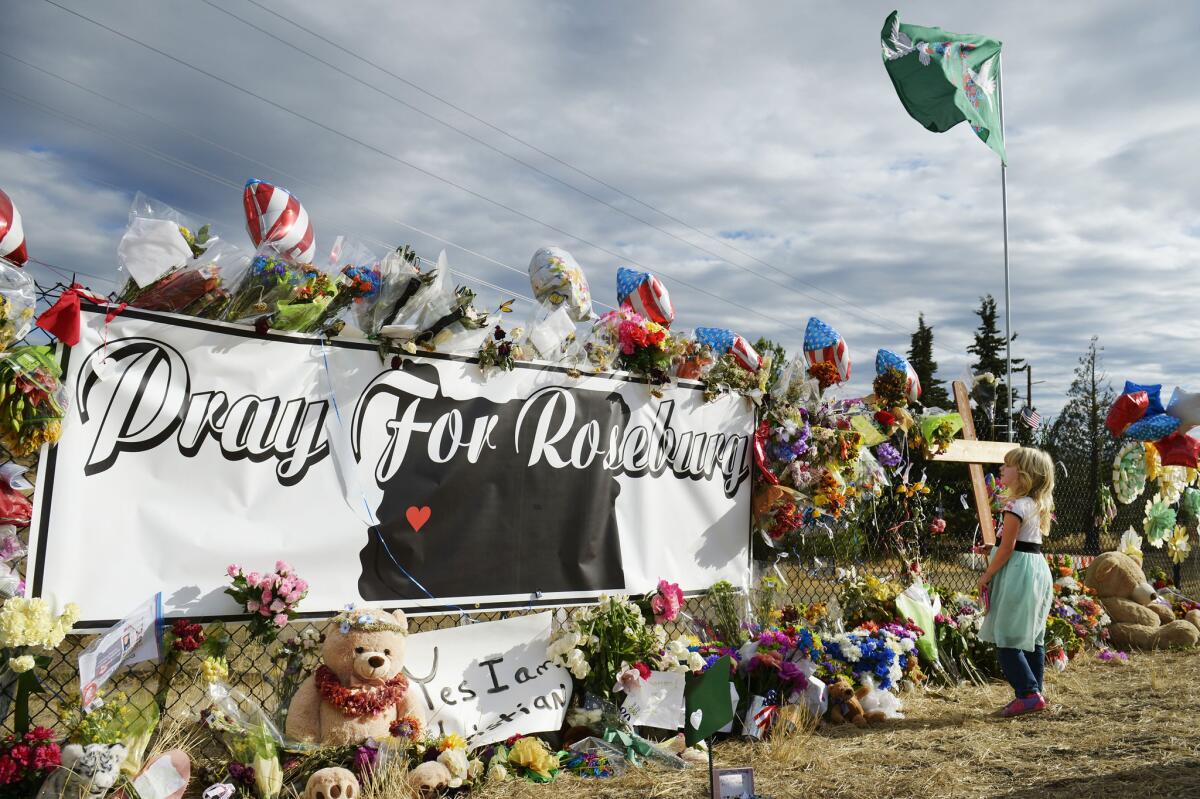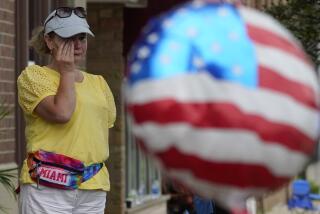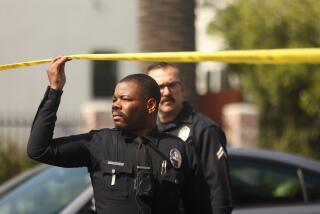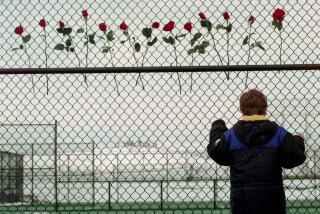Has the U.S. had 4 mass shootings this year or 353? Estimates vary that much

Bayleigh Case, of Roseburg, Ore., in October visits a makeshift memorial near the campus of Umpqua Community College Campus, scene of one of this year’s mass shootings in the U.S.
- Share via
The frequency of mass shootings is a uniquely American problem.
But be careful when you hear reports that say how often such shootings happen. They are not well-tracked by federal agencies, and the definition of a “mass shooting” varies so widely among public researchers that the numbers can be confusing.
One commonly cited database, run by Mother Jones magazine, says there have been four mass shootings in America this year.
Those four incidents occurred at a church in Charleston, S.C. (nine victims killed); a military recruitment center in Chattanooga, Tenn. (five victims killed); a community college in Roseburg, Ore. (nine victims killed); and now at a holiday party in San Bernardino on Wednesday (14 victims killed).
But another commonly cited source for mass shootings, the crowd-sourced Mass Shooting Tracker database, said that as of Friday there had been 353 mass shootings in the U.S. this year.
That would mean we’re averaging more than one mass shooting a day.
Here’s the difference: Mother Jones counts a mass shooting as any incident in which a lone gunman kills at least four people in a public place, while also excluding gang violence.
But the Mass Shooting Tracker — which is built by members of the social-sharing site Reddit, and which uses news reports as sources — defines a mass shooting as any incident, anywhere, in which at least four people are shot, but not necessarily killed.
Under this definition, Connecticut’s 2012 Sandy Hook Elementary School massacre, in which 26 students and staff members were killed, would hypothetically count the same as a shooting in which four people are shot and wounded in a personal dispute at a house party, even if the injured victims were not the intended targets.
Mass Shooting Tracker — explaining the thinking behind its criteria — cites a 2012 nightclub shooting in Jackson, Tenn., in which one person was killed and 18 people were wounded when a gunman shot at someone in a nightclub and other patrons returned fire. (The gunman was among the wounded.)
“Under the incorrect definition of mass shooting, that event would not be considered a mass shooting!” the Mass Shooting Tracker site, www.shootingtracker.com, says in an explanation of its data. “Arguing that 18 people shot during one event is not a mass shooting is absurd.”
But criminologist James Alan Fox of Northeastern University in Boston, who studies mass killings, says the Mass Shooting Tracker totals are flawed.
“Four people with minor injuries, they count it, but three people killed, they don’t count it,” Fox said of Mass Shooting Tracker’s criteria. “Everyone would agree three people killed is worse than four people with minor injuries.... It’s really blending together apples with watermelons.”
A Los Angeles Times examination of Mass Shooting Tracker’s data showed that in 42% of the 353 shootings the site counted in 2015, no one was killed. (Other news outlets previously reported this week that the tracker had logged 355 mass shootings, not 353; it’s not clear where the outlets got that number or whether the site downgraded its total as of Friday.)
The tracker has also only been gathering data since 2013, making it difficult to evaluate whether mass shootings are getting more or less common.
Mother Jones’ data — which go back to the 1980s — are much more selective, and exclude massacres that happen inside private homes.
Mother Jones has previously explained that its “focus is on public mass shootings in which the motive appeared to be indiscriminate killing,” calling it a specific phenomenon that the publication argues is getting more common.
As a result, missing from the Mother Jones’ database of mass shootings this year was the August massacre in which a Houston man was accused of breaking into his ex-girlfriend’s home and fatally shooting eight people, six of whom were children.
“While all the victims are important, conflating those many other crimes with indiscriminate slaughter in public venues obscures our understanding of this complicated and growing problem,” Mark Follman, Mother Jones national affairs editor, wrote in a New York Times opinion piece Thursday.
“Everyone is desperate to know why these attacks happen and how we might stop them — and we can’t know, unless we collect and focus on useful data that filter out the noise.”
But Fox, the Northeastern criminologist, has also criticized Mother Jones for excluding domestic-violence incidents from mass-shooting totals. “If you’re one of the victims of a mass killing, it doesn’t matter if a person kills you is a brother or a stranger; you’re just as dead,” Fox said.
Fox also criticized Mother Jones for having inconsistent criteria, sometimes breaking its own one-gunman rule to include the two-shooter massacres at Columbine High School and in San Bernardino in their total.
The most complete (and least confusing) data set, according to Fox, is kept by the Congressional Research Service, which released a report on mass shootings in July.
The research service’s report said the U.S. averaged about 21 mass shootings per year from 1999 to 2013 in which four or more people were killed either in public or private.
That 15-year span saw 317 such mass shootings in which a total of 1,554 people were killed, and the number of shootings fluctuated “sporadically” from year to year.
(For these figures, the research service report did not use Congress’ definition, passed after the 2012 Newtown, Conn., massacre, which defined a mass killing as three or more slain victims.)
When the Congressional Research Service used data from criminologist Grant Duwe to count mass shootings that happened in public and left four dead — similar to the criteria examined by Mother Jones — the service found that the U.S. averaged 4.5 mass public shootings per year from 2010 to 2013.
That was a slight increase from an average of 4.0 mass public shootings per year in the 1990s, and a drastic increase over the 1.1 public shootings measured per year in 1970s, according to the research service.
The Congressional Research Service also concluded that Congress should consider directing federal law-enforcement agencies to improve their tracking of multiple-victim homicides.
“With improved data, policymakers would arguably have additional vantage points from which to assess the legislative proposals that are inevitably made in the wake of these tragedies,” the research service said.
Fox doesn’t make distinctions between public and private mass shootings, and he has kept his own data that indicate the country has averaged about 20 mass shootings with four or more people killed “for decades.”
“The only thing that has really increased is fear,” Fox said.
Twitter: @MattDPearce
MORE ON SAN BERNARDINO
Rampage killers led secret life, hiding plans and weapons
San Bernardino attacker was ‘typical housewife,’ lawyer says
California lawmakers revive gun control ideas after San Bernardino attack
More to Read
Sign up for Essential California
The most important California stories and recommendations in your inbox every morning.
You may occasionally receive promotional content from the Los Angeles Times.











